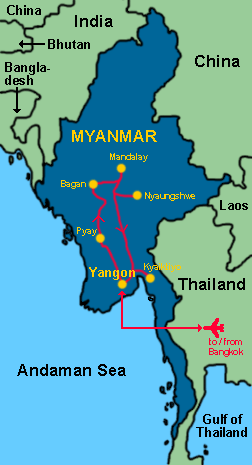


























Myanmar |
Photos of Myanmar | |||||
In the first of our four weeks in Myanmar, we quickly headed north from Yangon to Bagan, with stops along the way in pleasant Pyay and ordinary Magwe. The smallish town of Pyay is an ideal introduction to the country with its friendly people, the atmospheric Shwesandaw Paya, the quirky Bespectacled Buddha, the dusty and red betel-spit stained streets, and the nearby ancient city of Thayekhittaya. The plain of Bagan with hundreds and hundreds of pahtos and zedis will impress even the most seasoned traveler who may think to have seen it all with Angkor Wat, Machu Picchu, Tikal, ... The second week we spent in and around Mandalay marveling at teak monasteries and Kuthodaw Paya, the possibly largest but surely heaviest book of the world consisting of over 700 marble slabs. As well, we enjoyed splendid views of Mandalay Hill from Sandamuni Paya. The highly revered Buddha statue at Mahamuni Paya is covered with a thick layer of gold leaf almost to the point beyond recognition, the mirror hall at Kyauktawgyi Paya shimmers in beautiful shades of blue after sunset, and attending a performance of the a-nyeint pwe troupe Moustache Brothers is a not-to-be-missed lifetime experience. Mandalay is surrounded by ancient cities, two of which we visited: Mingun, and Amarapura with the scenic U Bein bridge. We also spent two nights in Pyin U Lwin, a hill station east of Mandalay with a much cooler climate. From Mandalay, we moved on to Nyaungshwe at Inle Lake. Nyaungshwe's resident population of monks and nuns is enormous considering the town's size, as is the number of monasteries in and around Nyaungshwe. On the lake, watching the leg rowers' ingenious technique of steering a boat with one leg wrapped around the oar while standing on the other leg is alone worth the long mountainous bus ride to get there. Furthermore, the floating villages and gardens of Kaylarywa and Thale U are particularly picturesque, and the views of Inle Lake from a hill close to Indein are fantastic. During our last week, we let ourselves be soaked in the spirituality of Kyaiktiyo, a golden rock and zedi precariously balancing over the edge at the top of Mt. Kyaikto. On the way back to Yangon, we took a cursory look at Bago with its four huge sitting Buddhas at Kyaik Pun Paya, and its even larger reclining Buddha Shwethalyaung. In Yangon, we had a few days to look at its former colonial glory, the reclining Buddha Chaukhtatgyi, and the mirrors of modern Botataung Paya. We strolled through Yangon's markets, visited the white elephant Sin Phyu Taw at Abayalarbarmuni, and are still awed by the breathtakingly elegant beauty of Shwedagon Paya. |
|||||||||||||||||||||||||||||||||||||||||||||||||||||||||||||||||||||||||






